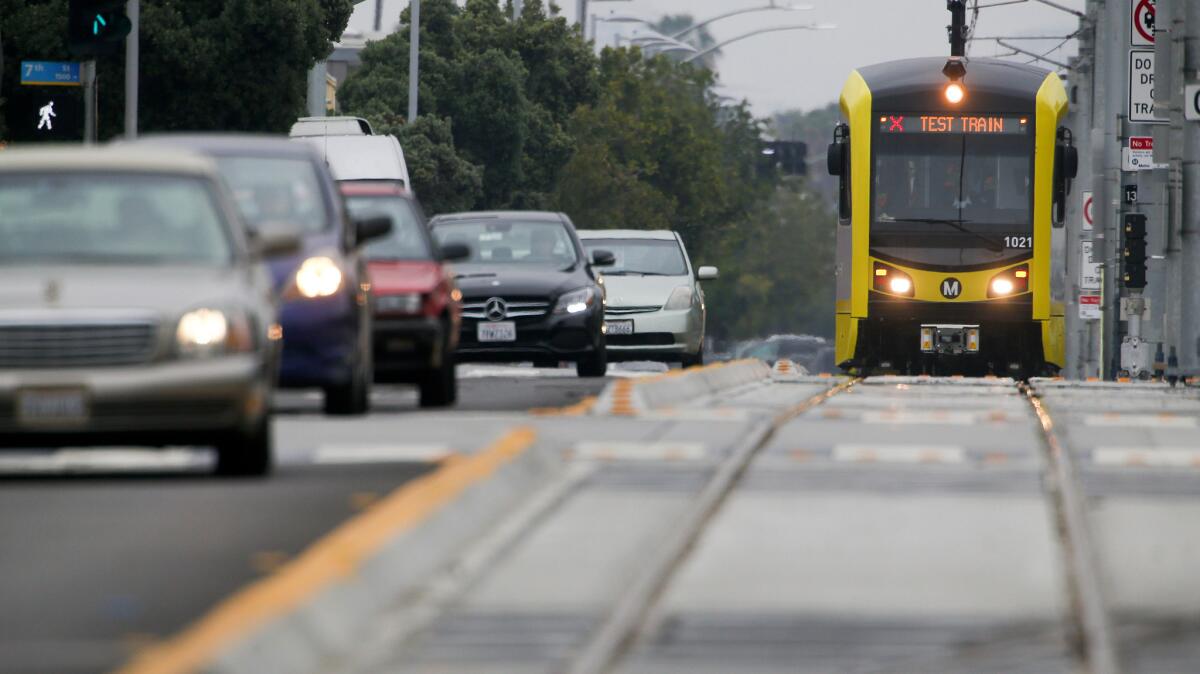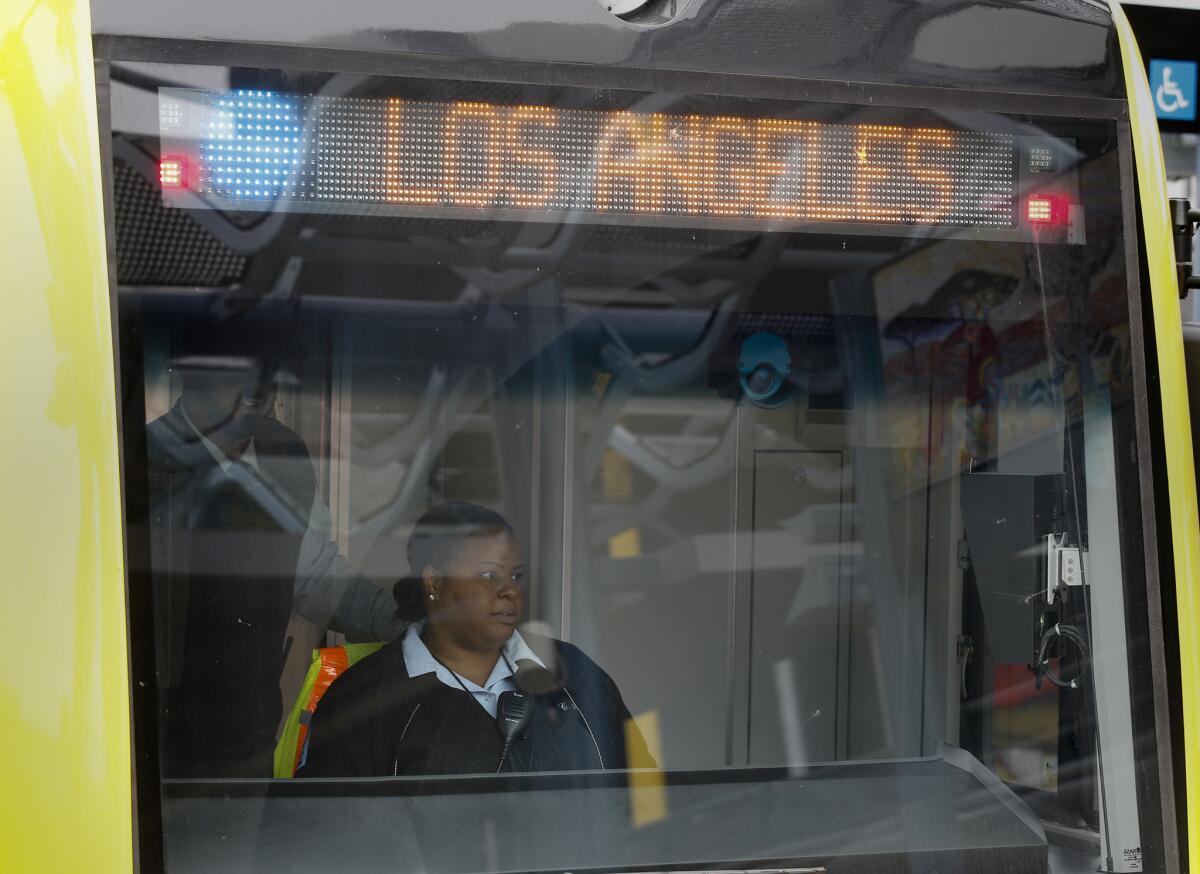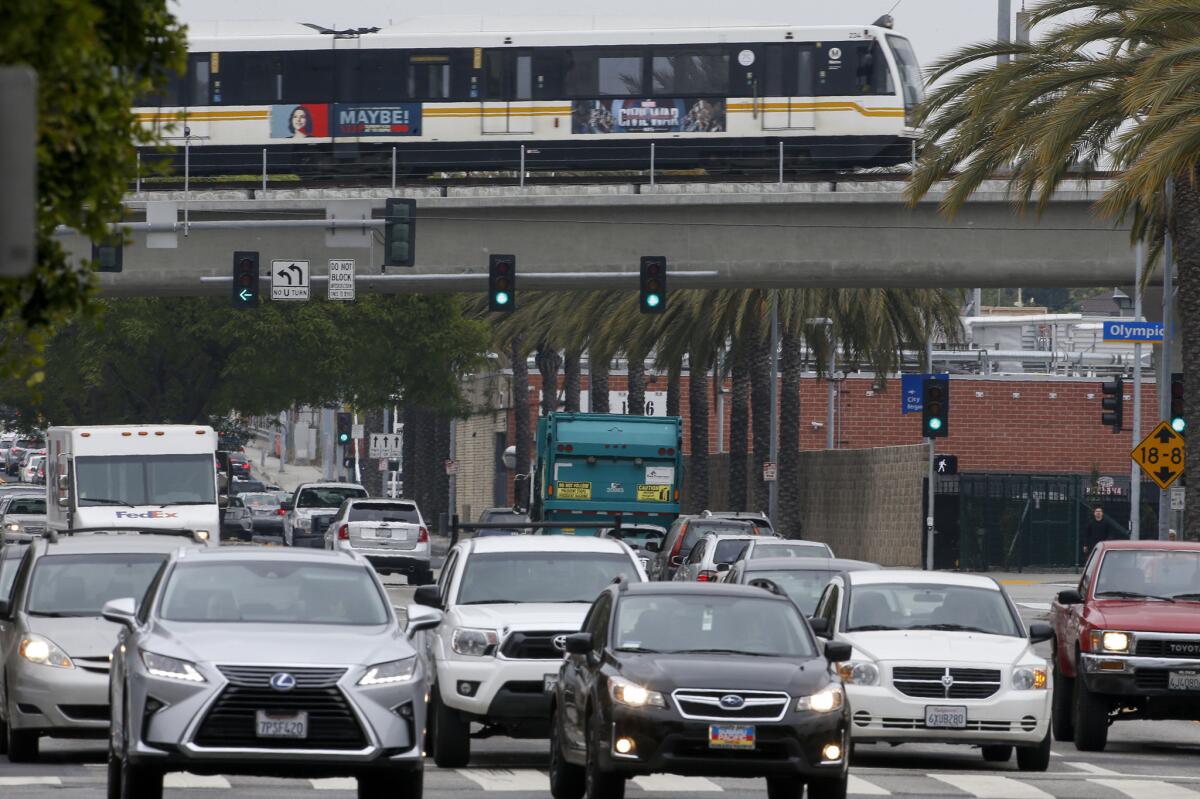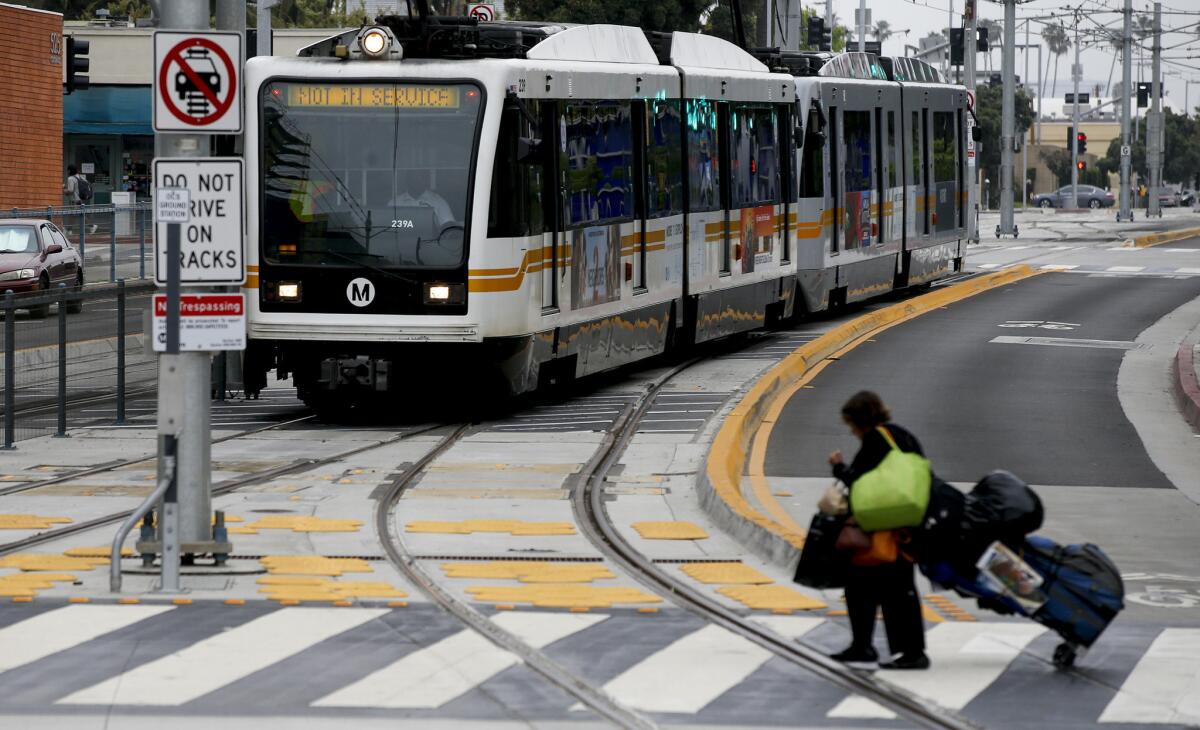You can finally ride the Expo Line from L.A. to Santa Monica. Here’s why the trip takes 50 minutes.

- Share via
When the long-awaited Expo Line extension opens Friday at noon, passengers will ride from downtown Los Angeles to Santa Monica in 50 minutes.
That’s an improvement over the ugly rush-hour commutes many days on the 10 Freeway. But it’s roughly as long as the trip took on the old Pacific Electric Red Cars, which operated a similar route six decades ago.
Speed is one of the biggest challenges facing regional planners as they try to coax Los Angeles drivers out of their cars and onto public transit. Metropolitan Transportation Authority officials say they hope to convert 20% to 25% of Angelenos into regular transit riders, triple the current percentage.
See the most-read stories this hour >>
Although the region’s ambitious rail building boom will help, experts say, the mandate would be easier if trains and buses made for a quicker trip than a car.
Unlike mass transit systems in other major cities, such as New York and Washington, the majority of L.A.’s 105-mile passenger rail network runs at street level, rather than elevated or underground. That helps keep construction costs lower, but means the speed of the trains is dictated at least in part by the region’s infamous traffic.
“To have a lot of people riding the train, it needs to be a competitive service, which light rail is not always,” said Lisa Schweitzer, a USC associate professor in transportation and urban planning.
Trains heading north into downtown Los Angeles frequently stop at traffic lights, she said, and are rarely faster than bus lines operating on congested streets. The train’s travel time isn’t “terrible,” she said, “but longer than it should be.”
Most light-rail vehicles are capable of speeds up to 60 mph, three times faster than the Expo Line’s average. On sections of the line that run at street level, Expo Line trains follow the speed limit, typically 30 mph to 35 mph.
Metro’s long road to the Expo Line began more than three decades ago, after a series of subway construction disasters and persistent cost overruns.
The 1985 methane gas explosion that left 23 people hurt, and a 1995 sinkhole on Hollywood Boulevard, sparked laws at home and in Washington that banned the use of federal and local dollars for subway construction.
So transportation planners turned to other options to link the Westside and downtown. They quickly discarded an elevated train concept along Wilshire Boulevard, but continued to study a light-rail line along a right-of-way where Southern Pacific trains had once run.
By eliminating land acquisition and tunneling, officials reasoned, the agency would save enough money to create a rapid-bus route along Wilshire.
See more of our top stories on Facebook >>
Still, consultants noted in 1998, light-rail had its drawbacks. Trains running at street level through intersections posed “some safety considerations,” they said, including collisions with cars.
Today, trains move quickly along the 6.6-mile extension, slicing through Palms, Sawtelle and West Los Angeles on primarily elevated tracks before re-entering mixed traffic in Santa Monica. The trip from Culver City to the new terminus, at 4th Street and Colorado Avenue, will take about 22 minutes.

But the design of the eastern half of the line, which opened four years ago, continues to dog Metro. Trains run almost entirely at street level, passing through 29 intersections, only six of which have crossing arms to prevent cars from cutting in.
Los Angeles has tried to coordinate stoplights along the route to give trains a green light wherever possible, said Sean Skehan, a senior transportation engineer. But if a train leaves a station behind schedule, or is held up by a driver pulling across the tracks, the light will eventually change.
An online petition with nearly 1,400 signatures, prompted by a story in the L.A. Weekly, asks transportation officials give Metro trains “signal pre-emption,” meaning lights would immediately change to green when a train approached, the same system used by ambulances and firetrucks.

With an estimated 64,000 daily trips on the line by 2030, the Expo Line should get priority, advocates said.
“Slowing a train down isn’t the way to get people out of their cars,” wrote one petitioner. “Nobody wants to sit in a traffic jam ON A TRAIN!” another wrote.
But even total signal priority wouldn’t solve congestion issues at the city’s most troubled rail junction, Skehan said. At Washington Boulevard and Flower Street, the Expo Line and Blue Line converge onto a shared track. Because Blue Line trains can be longer than a city block, they can obstruct more than one intersection at a time. As a result, they mostly receive the first green light, meaning Expo Line trains often sit and wait.
Northbound and southbound trains pass by so frequently during peak periods that pedestrians and drivers could wait for five minutes before crossing if trains always received priority, he said.
There are times when the train has to stop briefly, or not so briefly.
— Sean Skehan, a senior transportation for the L.A. Department of Transportation, delays when light rail trains converge on downtown L.A.
“There are times when the train has to stop briefly, or not so briefly,” Skehan said. The typical light cycle in downtown is 1 minute, so a train that just misses a green light could sit for nearly 60 seconds before restarting — not a torturous wait, but long enough to irritate passengers.
Stretches of track at street level, without gates, are the most vulnerable part of the Metro rail system, and one of the leading causes of major delays. In the last three months alone, the Expo Line has struck three cars sitting on the tracks in the downtown area.
The answer, Skehan said, is to untangle cars and trains from the same routes wherever possible, either by tunneling or building bridges. But both are costly options. Major grade-crossing improvements, such as building an overpass, can cost more than $20 million, which poses difficulties for California transportation agencies with long project wish lists.
“As soon as you start putting things above ground, or putting things below ground, your capital costs go up,” Schweitzer said. “When that happens, people who are cognizant of the cost and benefits say, ‘Well, darn, if we were going to put it under the ground, we could have had a subway.”
Another way to speed up the trains — express service — isn’t on the table. Most of the Metro rail system has just one set of tracks in each direction, in part because the agency built rail along existing rights-of-way, and in part because laying more track and building extra platforms costs more.

“It was considered, but it was impractical,” Metro spokesman Paul Gonzales said of running Expo Line express trains. “You’re eventually going to catch up with the train in front of you.”
A decade ago, Metro tried running express trains on the Gold Line between Union Station and Pasadena during peak periods. Officials had hoped that shaving five minutes off the 34-minute trip, skipping eight of 13 stations, would boost lackluster ridership.
But express trains blowing past crowded platforms at rush hour confused riders, officials said, and the local trains became more crowded because Metro did not add cars. The service stopped a year later.
Still, Metro staff point out, 50 minutes to Santa Monica is a vast improvement over current east-west bus routes, which take about an hour and a half. And, they say, the hope is that commuters will see the other benefits.
Commute times are generally predictable. Passengers can read, or nap, or watch the scenery flash by. And a one-way trip costs $1.75, about the cost of half a gallon of gas.
ALSO
Lawmakers block effort to make child death records secret
California’s fight against the Zika-carrying ‘cockroach of mosquitoes’
Counter-terrorism security increases at LAX after EgyptAir Flight 804 disappears
For more transportation news, follow @laura_nelson on Twitter.
More to Read
Sign up for Essential California
The most important California stories and recommendations in your inbox every morning.
You may occasionally receive promotional content from the Los Angeles Times.











